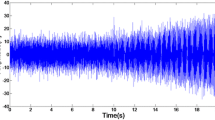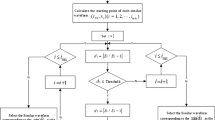Abstract
Multi-scale dispersion entropy (MDE1D) is an effective nonlinear dynamic tool to characterize the complexity of time series and has been extensively applied to mechanical fault diagnosis. However, with the increase of scale factor, the values of MDE1D often fluctuate largely, resulting in poor stability. Besides, it only extracts the complexity information from the time domain of vibration signal, while the complexity information in the frequency domain is ignored. To enhance the stability of MDE1D and extract the complexity characteristics from the time–frequency domain of vibration signal, this paper first develops a two-dimensional multi-scale reverse dispersion entropy (MRDE2D), inspired by the MDE1D and two-dimensional multi-scale dispersion entropy (MDE2D) through introducing the “distance information from white noise”. Then a two-dimensional multi-scale time–frequency reverse dispersion entropy (MTFRDE2D) combined with time–frequency analysis is proposed. After that, considering that the length of the coarse-grained sequence used in the multi-scale coarse-grained process of MTFRDE2D will become shorter and shorter with the increase of scale factor, resulting in a loss of potentially useful information, the two-dimensional composite multi-scale time–frequency reverse dispersion entropy (CMTFRDE2D) is proposed through using the composite coarse-grained process. The effectiveness and advantages of CMTFRDE2D algorithm are demonstrated by analyzing different kinds of noise signals. Following that, a new rolling bearing fault diagnosis method is proposed based on the CMTFRDE2D for feature extraction and gravitational search algorithm optimized support vector machine for mode identification. The proposed fault diagnosis method is employed on two rolling bearing test data sets and also compared with the existing MTFRDE2D,- MRDE2D,- MDE2D,- and MDE1D-based fault diagnosis methods. The analysis results reveal that the proposed fault diagnosis method can successfully extract the fault information from rolling bearing vibration signals in time–frequency domain and can accurately identify different fault locations and severities of rolling bearings with certain advantages.


















Similar content being viewed by others
Data availability
The datasets generated during and/or analysed during the current study are available from the corresponding author on reasonable request.
Abbreviations
- ApEn1D :
-
Approximate entropy
- SampEn1D :
-
Sample entropy
- FE1D :
-
Fuzzy entropy
- PE1D :
-
Permutation entropy
- DE1D :
-
Dispersion Entropy
- RDE1D :
-
Reverse dispersion entropy
- MDE1D :
-
Multi-scale dispersion entropy
- MDE2D :
-
Two-dimensional multi-scale dispersion entropy
- MRDE2D :
-
Two-dimensional multi-scale reverse dispersion entropy
- MTFRDE2D :
-
Two-dimensional multi-scale time–frequency reverse dispersion entropy
- CMTFRDE2D :
-
Two-dimensional composite multi-scale time–frequency reverse dispersion entropy
- SVM:
-
Support vector machine
- GSA:
-
Gravitational search algorithm
- PSO:
-
Particle swarm optimization
- CSO:
-
Chicken swarm optimization
References
Lin, J., Chen, Q.: Fault diagnosis of rolling bearings based on multifractal detrended fluctuation analysis and Mahalanobis distance criterion. Mech. Syst. Signal Process. 38(2), 515–533 (2013)
Zheng, J., Pan, H., Yang, S., et al.: Adaptive parameterless empirical wavelet transform based time-frequency analysis method and its application to rotor rubbing fault diagnosis. Signal Process. 130, 305–314 (2017)
Feng, K., Wang, K., Ni, Q., et al.: A phase angle based diagnostic scheme to planetary gear faults diagnostics under non-stationary operational conditions. J. Sound Vib. 408, 190–209 (2017)
Pincus, S.M.: Approximate entropy as a measure of system complexity. Proc. Natl. Acad. Sci. 88(6), 2297–2301 (1991)
Richman, J.S., Moorman, J.R.: Physiological time-series analysis using approximate entropy and sample entropy. Am. J. Physiol. Heart Circ. Physiol. 278(6), H2039–H2049 (2000)
**ang, D., Ge, S.: A model of fault feature extraction based on wavelet packet sample entropy and manifold learning. J. Vib. Shock 33(11), 1–5 (2014)
Zheng, J., Cheng, J., Yang, Y.: A rolling bearing fault diagnosis approach based on LCD and fuzzy entropy. Mech. Mach. Theory 70, 441–453 (2013)
Bandt, C., Pompe, B.: Permutation entropy: a natural complexity measure for time series. Phys. Rev. Lett. 88(17), 174102 (2002)
Kuai, M., Cheng, G., Pang, Y., et al.: Research of planetary gear fault diagnosis based on permutation entropy of CEEMDAN and ANFIS. Sensors 18(3), 782 (2018)
Ying, W., Zheng, J., Pan, H., et al.: Permutation entropy-based improved uniform phase empirical mode decomposition for mechanical fault diagnosis. Digital Signal Process. 117, 103167 (2021)
Rostaghi, M., Azami, H.: Dispersion entropy: a measure for time-series analysis. IEEE Signal Process. Lett. 23(5), 610–614 (2016)
Rostaghi, M., Ashory, M.R., Azami, H.: Application of dispersion entropy to status characterization of rotary machines. J. Sound Vib. 438, 291–308 (2019)
Li, Y., Gao, X., Wang, L.: Reverse dispersion entropy: a new complexity measure for sensor signal. Sensors 19(23), 5203 (2019)
H. Azami, E. Kinney-Lang, A. Ebied et al. Multiscale dispersion entropy for the regional analysis of resting-state magnetoencephalogram complexity in Alzheimer's disease. In: 39th Annual International Conference of the IEEE Engineering in Medicine and Biology Society (EMBC). IEEE, (2017). pp 3182–3185.
Azami, H., Silva, L.E.V., Omoto, A.C.M., et al.: Two-dimensional dispersion entropy: an information-theoretic method for irregularity analysis of images. Signal Process. Image Commun. 75, 178–187 (2019)
Furlong, R., Hilal, M., O’brien, V., et al.: Parameter analysis of multiscale two-dimensional fuzzy and dispersion entropy measures using machine learning classification. Entropy 23(10), 1303 (2021)
Park, J., Kim, Y., Na, K., et al.: An image-based feature extraction method for fault diagnosis of variable-speed rotating machinery. Mech. Syst. Signal Process. 167, 108524 (2022)
Al-Badour, F., Sunar, M., Cheded, L.: Vibration analysis of rotating machinery using time–frequency analysis and wavelet techniques. Mech. Syst. Signal Process. 25(6), 2083–2101 (2011)
Silva, L.E.V., Senra Filho, A.C.S., Fazan, V.P.S., et al.: Two-dimensional sample entropy: assessing image texture through irregularity. Biomed. Phys. Eng. Express 2(4), 045002 (2016)
Ahmed, A.G.M., Perrier, H., Coeurjolly, D., et al.: Low-discrepancy blue noise sampling. ACM Trans. Graph. (TOG) 35(6), 1–13 (2016)
Hilal, M., Berthin, C., Martin, L., et al.: Bidimensional multiscale fuzzy entropy and its application to pseudoxanthoma elasticum. IEEE Trans. Biomed. Eng. 67(7), 2015–2022 (2019)
Adamer, M.F., Harrington, H.A., Gaffney, E.A., et al.: Coloured noise from stochastic inflows in reaction–diffusion systems. Bull. Math. Biol. 82(4), 1–28 (2020)
Zheng, J., Pan, H., Yang, S., et al.: Generalized composite multiscale permutation entropy and Laplacian score based rolling bearing fault diagnosis. Mech. Syst. Signal Process. 99, 229–243 (2018)
Hu, X., Che, Y., Lin, X., et al.: Health prognosis for electric vehicle battery packs: A data-driven approach. IEEE/ASME Trans. Mechatron. 25(6), 2622–2632 (2020)
Li, Y., Yang, Y., Wang, X., et al.: Early fault diagnosis of rolling bearings based on hierarchical symbol dynamic entropy and binary tree support vector machine. J. Sound Vib. 428, 72–86 (2018)
Coello, C.A.C., Pulido, G.T., Lechuga, M.S.: Handling multiple objectives with particle swarm optimization. IEEE Trans. Evol. Comput. 8(3), 256–279 (2004)
Deb, S., Gao, X.Z., Tammi, K., et al.: A new teaching–learning-based chicken swarm optimization algorithm. Soft. Comput. 24(7), 5313–5331 (2020)
Rashedi, E., Rashedi, E., Nezamabadi-Pour, H.: A comprehensive survey on gravitational search algorithm. Swarm Evol. Comput. 41, 141–158 (2018)
Zandevakili, H., Rashedi, E., Mahani, A.: Gravitational search algorithm with both attractive and repulsive forces. Soft. Comput. 23(3), 783–825 (2019)
Rashedi, E., Nezamabadi-Pour, H., Saryazdi, S.: GSA: a gravitational search algorithm. Inf. Sci. 179(13), 2232–2248 (2009)
Zheng, J., Gu, M., Pan, H., et al.: A fault classification method for rolling bearing based on multisynchrosqueezing transform and WOA-SMM. IEEE Access 8, 215355–215364 (2020)
Bearing Data Center Website: Case Western Reserve University [DB/OL] [2017–6–20]. http://www.eecs.cwru.edu/laboratory/bearing.
Acknowledgements
This work was supported by the National Natural Science Foundation of China (No. 51975004), the Natural Science Foundation of Anhui Province of China (No. 2008085QE215), and the State Key Laboratory of Mechanical Transmissions (SKLMT-MSKFKT-202107).
Author information
Authors and Affiliations
Corresponding author
Ethics declarations
Conflict of interest
The authors declare that they have no known competing financial interests or personal relationships that could have appeared to influence the work reported in this paper.
Ethical approval
The authors declare that they have adhered to the ethical standards of research execution.
Additional information
Publisher's Note
Springer Nature remains neutral with regard to jurisdictional claims in published maps and institutional affiliations.
Rights and permissions
Springer Nature or its licensor (e.g. a society or other partner) holds exclusive rights to this article under a publishing agreement with the author(s) or other rightsholder(s); author self-archiving of the accepted manuscript version of this article is solely governed by the terms of such publishing agreement and applicable law.
About this article
Cite this article
Li, J., Zheng, J., Pan, H. et al. Two-dimensional composite multi-scale time–frequency reverse dispersion entropy-based fault diagnosis for rolling bearing. Nonlinear Dyn 111, 7525–7546 (2023). https://doi.org/10.1007/s11071-023-08250-y
Received:
Accepted:
Published:
Issue Date:
DOI: https://doi.org/10.1007/s11071-023-08250-y




